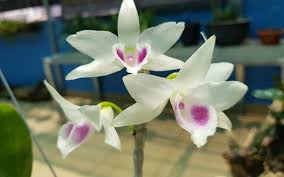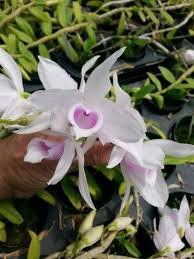
## Introduction
Phalaenopsis orchids, commonly known as moth orchids, are among the most popular orchids cultivated worldwide. Renowned for their stunning beauty, long-lasting blooms, and ease of care, these orchids have found a place in many gardens and homes. However, their interactions with other plants in the garden ecosystem play a crucial role in their growth and health. This article explores the various interactions between Phalaenopsis orchids and other plants, focusing on symbiotic relationships, companion planting, environmental benefits, and challenges posed by neighboring plants.
## Understanding Phalaenopsis Orchids
Before delving into interactions, it’s essential to understand the nature and needs of Phalaenopsis orchids. These epiphytic orchids thrive in tropical regions, where they naturally grow on trees, using their aerial roots to absorb moisture and nutrients from the air and surrounding environment. They prefer bright, indirect light, warm temperatures, and high humidity, making them a favorite in indoor and outdoor gardens alike.
### Key Characteristics of Phalaenopsis Orchids
– **Growth Habit**: Phalaenopsis orchids grow as epiphytes, which means they typically do not require soil to thrive. Instead, they use their roots to attach to trees or other structures while drawing nutrients from the air and rain.
– **Flowering**: These orchids produce long-lasting blooms that can last for several months, showcasing a variety of colors and patterns. They often bloom once or twice a year, depending on the growing conditions and care.
– **Root System**: The root system of Phalaenopsis orchids is unique. Their roots are thick and fleshy, capable of storing moisture and nutrients, which makes them sensitive to overwatering.
## The Role of Companion Plants
Companion planting is the practice of growing different plants in proximity to enhance growth, deter pests, and improve overall garden health. Phalaenopsis orchids can benefit from carefully chosen companion plants that provide mutual advantages.
### 1. Enhancing Humidity
Phalaenopsis orchids thrive in high humidity levels, typically between 50% to 70%. Companion plants that naturally create a humid microenvironment can be beneficial. Here are some suitable companions:
– **Ferns**: Ferns, such as Boston ferns (Nephrolepis exaltata), are excellent companions for Phalaenopsis orchids. They prefer similar humidity levels and can help maintain moisture in the air, benefiting the orchid’s health.
– **Bromeliads**: These tropical plants retain water in their leaf axils, creating a humid microclimate around them. When planted near Phalaenopsis orchids, they can enhance humidity levels, which is crucial for the orchids’ well-being.
### 2. Providing Shade
Phalaenopsis orchids prefer bright, indirect light. Companion plants that provide partial shade can help protect orchids from intense sunlight, preventing leaf burn and ensuring healthy growth. Suitable shade-providing plants include:
– **Lobelia**: This trailing plant can create a lush ground cover that provides shade while adding vibrant color to the garden.
– **Coleus**: Known for its striking foliage, coleus can create a shaded area, protecting Phalaenopsis orchids from harsh sunlight.
### 3. Nutrient Exchange
Some companion plants can contribute to soil health and nutrient availability, benefiting the Phalaenopsis orchids growing nearby. Consider the following plants:
– **Leguminous Plants**: Beans and peas can fix nitrogen in the soil, enriching the nutrient content for surrounding plants, including orchids.
– **Comfrey**: Known for its deep roots, comfrey can draw up nutrients from the soil, making them available to nearby plants through leaf drop and decomposition.
## The Impact of Plant Interactions on Pest Control
### 1. Natural Pest Deterrents
Certain companion plants can act as natural pest deterrents, helping to protect Phalaenopsis orchids from harmful insects. Plants with strong fragrances or chemical properties can repel pests, creating a healthier environment. Some effective natural pest deterrents include:
– **Marigolds**: These flowers are known for repelling nematodes and aphids. Planting marigolds near Phalaenopsis orchids can help keep these pests at bay.
– **Lavender**: The strong scent of lavender repels various insects, including mosquitoes and moths, which can be harmful to orchids.
### 2. Attracting Beneficial Insects
In addition to repelling pests, certain plants can attract beneficial insects that prey on harmful pests. This natural form of pest control can create a balanced ecosystem in the garden. Consider planting:
– **Basil**: This aromatic herb attracts beneficial insects like ladybugs and lacewings, which feed on aphids and other pests that can harm orchids.
– **Yarrow**: Known for attracting predatory insects, yarrow can help maintain pest populations at manageable levels, supporting the health of nearby Phalaenopsis orchids.
## Environmental Benefits of Plant Interactions
The interactions between Phalaenopsis orchids and other plants contribute to a healthier garden ecosystem. Here are some key environmental benefits:
### 1. Soil Health Improvement
Diverse plantings in the garden promote soil health through various mechanisms:
– **Root Interactions**: Different root systems can create a complex soil structure, improving aeration and drainage. This is particularly beneficial for Phalaenopsis orchids, which require well-draining media.
– **Organic Matter**: The decomposition of fallen leaves and plant material adds organic matter to the soil, enhancing nutrient availability and promoting microbial activity.
### 2. Pollinator Attraction
A diverse garden with various flowering plants attracts pollinators, which are essential for the reproduction of many plant species. While Phalaenopsis orchids are primarily self-pollinating, having other flowering plants nearby can enhance the overall biodiversity of the garden. Consider planting:
– **Bee Balm**: This vibrant flower attracts bees and butterflies, contributing to a pollinator-friendly garden.
– **Coneflowers**: These hardy perennials attract various pollinators, enhancing the garden’s biodiversity.
## Challenges of Plant Interactions
While there are numerous benefits to growing Phalaenopsis orchids alongside other plants, there can also be challenges that gardeners should consider.
### 1. Competition for Resources
When planting Phalaenopsis orchids with other plants, competition for resources can arise. Factors to consider include:
– **Water**: Plants with aggressive root systems may outcompete orchids for water, leading to stress or dehydration. It’s essential to monitor moisture levels and adjust watering practices accordingly.
– **Nutrients**: Some plants may absorb nutrients more efficiently, potentially depriving orchids of essential elements. Using organic fertilizers and maintaining balanced soil health can help mitigate this issue.
### 2. Pest and Disease Transfer
The presence of nearby plants can also pose risks in terms of pest and disease transfer. If one plant becomes infested, pests may easily spread to Phalaenopsis orchids. To manage this risk:
– **Regular Monitoring**: Keep a close eye on all plants for signs of pests or diseases. Early detection can prevent widespread issues.
– **Quarantine New Plants**: When introducing new plants to the garden, quarantine them for a few weeks to ensure they are pest-free before placing them near Phalaenopsis orchids.
## Caring for Phalaenopsis Orchids in Mixed Plantings
To ensure the health and beauty of Phalaenopsis orchids in a mixed plant environment, consider the following care tips:
### 1. Watering Practices
Proper watering is crucial for Phalaenopsis orchids, especially when planted alongside other plants. Here are some tips:
– **Watering Frequency**: Monitor the moisture levels of the potting medium and adjust the watering frequency based on the needs of all plants in the vicinity.
– **Water Quality**: Use distilled or rainwater when possible to avoid chemical build-up from tap water.
### 2. Fertilization Regimen
Maintaining a balanced fertilization regimen is essential for promoting healthy growth:
– **Balanced Fertilizer**: Use a balanced orchid fertilizer during the growing season to support all plants’ nutrient needs.
– **Organic Options**: Consider organic fertilizers, such as compost tea, to enrich the soil without the risk of chemical build-up.
### 3. Pruning and Maintenance
Regular pruning and maintenance of both Phalaenopsis orchids and companion plants are vital for preventing overcrowding and ensuring optimal growth conditions:
– **Prune Regularly**: Remove dead or yellowing leaves and spent blooms to encourage healthy growth and prevent disease.
– **Thin Out Plants**: If certain plants become too aggressive, consider thinning them out to reduce competition for resources.
## Conclusion
The interactions between Phalaenopsis orchids and other plants in the garden create a dynamic ecosystem that can enhance the beauty and health of all plants involved. By carefully selecting companion plants that provide humidity, shade, and pest control, gardeners can create a harmonious environment for their orchids to thrive. While challenges may arise, such as competition for resources and potential pest transfer, proper care and management can mitigate these risks. Ultimately, fostering beneficial plant interactions will lead to a more vibrant and healthy garden, allowing Phalaenopsis orchids to flourish alongside their companions.



